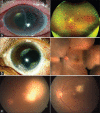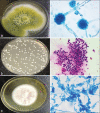Understanding the science of fungal endophthalmitis - AIOS 2021 Sengamedu Srinivas Badrinath Endowment Lecture
- PMID: 35225510
- PMCID: PMC9114621
- DOI: 10.4103/ijo.IJO_2329_21
Understanding the science of fungal endophthalmitis - AIOS 2021 Sengamedu Srinivas Badrinath Endowment Lecture
Abstract
Fungal endophthalmitis is a potentially blinding condition. It is more often reported from Asia, including India. The incidence is lower than bacterial endophthalmitis. But it is relatively more challenging to treat than bacterial endophthalmitis. Many eyes may need therapeutic keratoplasty and/or evisceration. The current mainstays of treatment are vitrectomy irrespective of the presenting vision, intravitreal antifungal agents, and systemic therapy; additionally, the patients could require prolonged treatment with repeat vitreous surgeries and intravitreal injections. Difficulty in clinical diagnosis, delay in microbiological culture, and limited options of antifungal drugs make the treatment more difficult and less rewarding. Three common fungi causing endophthalmitis are Aspergillus, Fusarium, and Candida. The former two are molds, often identified in exogenous endophthalmitis, postoperative and traumatic; the latter is yeast and is more often identified in endogenous endophthalmitis. A faster diagnosis with newer molecular microbiological technologies might help institute treatment earlier than it is currently possible. A target trial using big data from different regions of the world might emulate a randomized clinical trial to design a definite treatment strategy. Given fewer antifungal drugs, one must be mindful of antifungal stewardship to prevent resistance to the existing drugs.
Keywords: Antifungal stewardship; endophthalmitis; fungus; microbiology; minimum fungicidal concentration; outcome; pathology; treatment.
Conflict of interest statement
None
Figures





Comment in
-
Commentary: Fungal endophthalmitis - Newer insights into the diagnosis and management.Indian J Ophthalmol. 2022 Mar;70(3):777-778. doi: 10.4103/ijo.IJO_2878_21. Indian J Ophthalmol. 2022. PMID: 35225511 Free PMC article. No abstract available.
Similar articles
-
Endophthalmitis associated with fungal keratitis and penetrating injuries in North China.Eur J Ophthalmol. 2020 May;30(3):455-461. doi: 10.1177/1120672119833896. Epub 2019 Mar 4. Eur J Ophthalmol. 2020. PMID: 30832500
-
Fungal Endophthalmitis: Analysis of 730 Consecutive Eyes from 7 Tertiary Eye Care Centers in India.Ophthalmol Retina. 2022 Mar;6(3):243-251. doi: 10.1016/j.oret.2021.09.006. Epub 2021 Sep 20. Ophthalmol Retina. 2022. PMID: 34547530
-
Exogenous fungal endophthalmitis: microbiology and clinical outcomes.Ophthalmology. 2008 Sep;115(9):1501-7, 1507.e1-2. doi: 10.1016/j.ophtha.2008.02.027. Epub 2008 May 16. Ophthalmology. 2008. PMID: 18486220
-
Fungal endophthalmitis.Expert Rev Anti Infect Ther. 2011 Dec;9(12):1191-201. doi: 10.1586/eri.11.139. Expert Rev Anti Infect Ther. 2011. PMID: 22114969 Review.
-
Fusarium Causing Recalcitrant Post-operative endophthalmitis-Report of a Case with Review of Literature.Ocul Immunol Inflamm. 2022 May 19;30(4):989-991. doi: 10.1080/09273948.2020.1830124. Epub 2021 Oct 12. Ocul Immunol Inflamm. 2022. PMID: 34637660 Review.
Cited by
-
Endophthalmitis patients in Makassar City: molecular identification of pathogenic fungal profile.BMC Infect Dis. 2024 Nov 19;24(1):1320. doi: 10.1186/s12879-024-10209-2. BMC Infect Dis. 2024. PMID: 39563233 Free PMC article.
-
Global Transcriptomic Profiling of Innate and Adaptive Immunity During Aspergillus flavus Endophthalmitis in a Murine Model.Invest Ophthalmol Vis Sci. 2024 Apr 1;65(4):44. doi: 10.1167/iovs.65.4.44. Invest Ophthalmol Vis Sci. 2024. PMID: 38687493 Free PMC article.
-
Endogenous Fungal Endophthalmitis in a Patient After Fetal Reduction Surgery With a Literature Review: A Case Report.Infect Drug Resist. 2025 Mar 15;18:1465-1470. doi: 10.2147/IDR.S497721. eCollection 2025. Infect Drug Resist. 2025. PMID: 40115545 Free PMC article.
-
Spectrum of signs, symptoms, and treatment in amphotericin B-resistant Trichosporon endophthalmitis: A series of ten cases of post-cataract surgery cluster endophthalmitis.Indian J Ophthalmol. 2022 Nov;70(11):4004-4009. doi: 10.4103/ijo.IJO_1938_22. Indian J Ophthalmol. 2022. PMID: 36308145 Free PMC article.
-
Endogenous Intraocular Aspergillus Infection Associated With Systemic Vasculitis.Cureus. 2023 Jun 9;15(6):e40177. doi: 10.7759/cureus.40177. eCollection 2023 Jun. Cureus. 2023. PMID: 37431358 Free PMC article.
References
-
- Van Burik JH, Magee PT. Aspects of fungal pathogenesis in humans. Annu Rev Microbiol. 2001;55:743–72. - PubMed
-
- Romani L. Immunity to fungal infections. Nat Rev Immunol. 2011;11:275–88. - PubMed
-
- Kobayashi GS. Disease mechanism of fungi. Medical Microbiology. Chapter 74. 1996
-
- Gentile RC, Shukla S, Shah M, Ritterband DC, Engelbert M, Davis A, et al. Microbiological spectrum and antibiotic sensitivity in endophthalmitis:A 25-year review. Ophthalmology. 2014;121:1634–42. - PubMed
Publication types
MeSH terms
Substances
LinkOut - more resources
Full Text Sources

